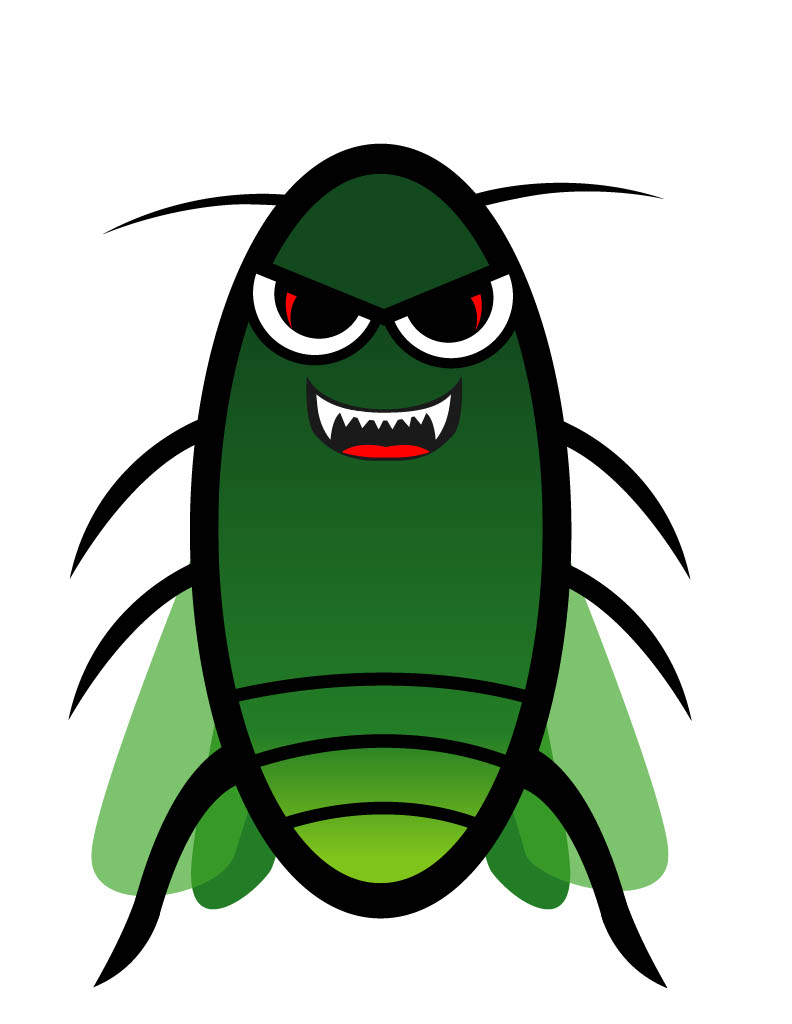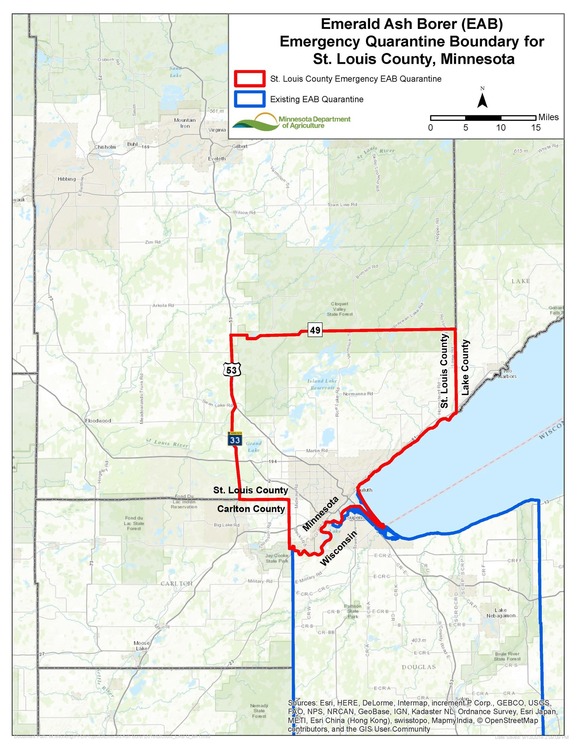Emerald Ash Borer (EAB)

Emerald Ash Borer (EAB) is a non-native wood-boring beetle that attacks ash trees. It is an invasive pest that has rapidly killed tens of millions of ash trees in the US and Canada. The larval stage of EAB feeds under the bark of ash trees, cutting off the flow of water and nutrients, resulting in the tree’s death. It is considered one of the most destructive forest pests ever seen in North America, causing the largest disturbance to our urban forest since Dutch Elm Disease.
The City continues to plant replacement trees for ash removed as part of the EAB management plan. We have and will continue a 1:1 planting to removal ratio throughout town. Individual trees will not necessarily be planted in the exact same location as a removed ash. Tree planting in Lakeside, East Hillside, along West Superior Street in Lincoln Park, in the West Duluth Business District along Central and Grand Avenues and informative brochures have been funded by a Great Lakes Restoration Initiative grant through the U.S. Department of Agriculture, Forest Service and the U.S. Environmental Protection Agency (EPA).
The City of Duluth has received $340,562 in grant funding from the Minnesota Department of Natural Resources between 2019 and 2022. These grants are designed to help communities protect their forests, mitigate and manage ash trees for EAB, and fund the planting of replacement trees.

What We are Doing
Emerald Ash Borer (EAB) was detected in Duluth in late 2015, but recently-discovered infestations seem to indicate the borer has been here for a few years already. Unfortunately, widespread ash tree die-off typically occurs within a few years of a local EAB detection. EAB-infested ash trees become brittle and dry and decline very quickly. Ash trees that have died from EAB have a greater risk for sudden failure, potentially causing harm to people and property.
You may have noticed some trees in Duluth neighborhoods are adorned with green ribbons. These ribbons are meant to raise awareness of the EAB and the consequences of infestation among ash trees the City now faces. However, a majority of these ash trees are fated to die from this invasive pest.
Among Duluth’s boulevard trees, ash is second only to maple in numbers. Approximately 3,000 boulevard ash trees were susceptible to EAB. Because of this, the City plans to conduct a combination of delayed removal by chemical injection and pre-emptive removal of living ash trees on boulevards in order to prevent hazardous conditions. Generally, larger and higher-value ash trees will be targeted with injection by the City while declining trees and those under 12” DBH (diameter at breast height) will be removed.
In addition, through a partnership with the Minnesota Department of Agriculture, the City of Duluth is testing out the use of a biological control method with stingless wasps. The wasps work to consume EAB larvae and can help prevent the spread of EAB onto other ash trees. The test area is restricted to Hartley Park. The wasps pose no dangers to humans. Read more about biocontrol HERE.
In accordance with the City Council-approved Emerald Ash Borer Management Plan, the City has performed boulevard ash tree injections and removals in all neighborhoods starting in 2017.
The Emerald Ash Borer Management Plan provides guidance to City staff on the approved management options for city-managed ash trees in response to the emerald ash borer infestation. The Plan was adopted by the Duluth City Council on December 12, 2016.
The rapid development of the EAB infestation since that time has prompted an update to the 2016 Plan to update factual information. The intent of the plan remains unchanged. The revisions were presented at two Natural Resources Commission meetings in November and December 2022. The Commission recommended approving the revisions, which were then approved by City Council on February 13, 2023.
What Residents Can Do
Property owners have the option to preserve an adjacent boulevard ash tree in lieu of removal. By preserving a tree, you take on the responsibility for scheduling and paying for ongoing treatment coordinated through a licensed tree care provider. The preservation treatment must be a pesticide injection by a certified tree care provider, as specified in the City’s EAB Management Plan. The City reserves the right to deny treatment if the tree shows signs of EAB infestation. Past injection of a boulevard tree by the City, individual or licensed tree care company does not guarantee retention of that tree.
Those landowners wishing to save their boulevard ash tree with injections should schedule an appointment with one of the above certified tree care providers. The tree care provider will take care of all paperwork needed by the City.
- Application for Boulevard Ash Injections - For Tree Care Providers
- Completed Boulevard Ash Injection Information - For Tree Care Providers
These providers will work with the City to determine if a tree is eligible for injection. Please note that pesticide injection is currently the best known preventative option, but DOES NOT guarantee indefinite protection from an EAB infestation. It is suggested you discuss this with a certified arborist before committing to preserving a boulevard tree.
Adult borers typically fly less than ½-mile from their emergence tree. Most long-distance movement of EAB has been directly traced to human movement of ash firewood and other infested materials. This is because the larvae feed and pupate within an inch of the bark and can emerge up to a couple years later. For this reason, the Minnesota Department of Agriculture has established quarantine restrictions for affected counties that regulate the movement of ash logs and lumber, ash tree waste, ash chips and mulch, as well as ALL Hardwood firewood.

The Current quarantine boundaries affecting Duluth are as follows:
- West boundary: St. Louis/Carlton County border traveling north on Minnesota Highway 33 to the intersection of U.S. Highway 53; then following U.S. Highway 53 north to the intersection of Three Lakes Road (County Highway 49)
- North boundary: Three Lakes Road (County Highway 49) at the intersection of U.S. Highway 53 traveling east to the intersection of Vermilion Trail; then the northern edge of Gnesen, North Star, and Alden Townships to the St. Louis/Lake County border
- East boundary: St. Louis/Lake County border
- South boundary: St. Louis County border and St. Louis/Carlton County border to Minnesota Highway 33
SE St. Louis County, which includes Duluth, is under quarantine. The materials mentioned above should not be moved out of the quarantined zone. You can find the map of current quarantined areas here: MDA Quarantine Map. Also see: Minnesota EAB quarantine information with links to the quarantine details, maps, and information about firewood restrictions.
It is also important to not unnecessarily disturb (prune, cut down, etc.) ash trees during the EAB “flight season.” This is the time of year that the adult beetle has emerged from the tree and is looking for new places to lay eggs. An adult will generally re-infest the same tree or one close by unless it is disturbed. Minimizing ash tree activities during this time can slow the spread of the infestation. The MN Dept. of Agriculture defines this period as May 1 – September 30, though in the Duluth area it is likely delayed slightly because it requires a certain amount of accumulated heat.
The City will be managing public trees, but you may have ash trees in your yard or on your property. First you should figure out if your tree is an ash tree. Your ash tree is considered at risk if it is within 15 miles of confirmed EAB detections, which can be viewed on the quarantine map by zooming into an area.
Because EAB kills ash, there are three main courses of action for trees on your property that may cause damage if they fall. You can preserve your tree by treating it with a pesticide at label-specified frequency. You can remove the tree. Or, you can wait and do nothing. Depending on your proximity to the EAB infestation, doing nothing may be fine for a while, but eventually you will want to remove or treat the tree. If you are located within the green-bordered "EAB generally infested area" in the above-linked quarantine map, decisions about your ash trees should be made soon. Removing the tree while it is still alive is less expensive and dangerous than letting it die standing. Dead trees can be brittle, dry, and fail unexpectedly. If you are taking trees down, remember not to take it outside of the quarantine zone!
Treating a tree with pesticides can preserve it. Treatments are most effective when applications begin before it gets infested, though they can also save ash trees with low levels of infestation. Please see the U of M Extension Office treatment considerations, use a decision guide, and contact a tree care professional or professional arborist to help you decide what you should do with your ash trees. If you are considering treating some of your trees, this guide covers some information about insecticide use. If you choose to hire a tree care provider ensure they are a licensed pesticide applicator.
Become familiar with the signs and symptoms of EAB infestation. There are many resources to help you with this including the U of M Extension website and this guide from the Emerald Ash Borer Information Network.
It can be difficult to detect EAB in the early stages of infestation. The infestation usually starts towards the top of the tree and works down over a number of years. The first signs to look for are increased woodpecker activity (lighter color where the bark has been removed and woodpecker holes) and thinning of the foliage. Bark cracking over insect galleries and exit holes may not be visible until the later stages of infestation.
Tracking infestations occurs at the state level. The MN Dept. of Agriculture is interested in monitoring the movement of EAB, so if you suspect you have identified an infested tree, note the exact location, take a digital photo if possible, and contact Arrest the Pest at 888-545-6684 or Arrest.the.Pest@state.mn.us.
If you are removing potentially hazardous ash trees on your property, you may want to replant another tree. You can contact a professional or use this guide to help you make a decision on what to plant. The only type of tree more common than ash in our urban forest is maple, so you may want to avoid them to increase the diversity of trees. You can also see what tree species the City of Duluth is currently planting on boulevards.

